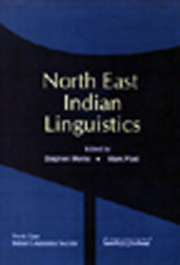Book contents
- Frontmatter
- Contents
- Introduction
- Foreword
- Phonology
- 1 Kurtöp Phonology in the Context of North East India
- 2 Working with Tones in North East India – The Tonal System of Numhpuk Singpho, Assam
- 3 Tonality and the Analysis of Sub-Minimal Words in Ao
- 4 Change with Continuity in the Boro-Garo Languages
- Lexicon
- Morphology, Syntax, and Semantics
- Language Description and Language Endangerment
2 - Working with Tones in North East India – The Tonal System of Numhpuk Singpho, Assam
from Phonology
Published online by Cambridge University Press: 26 October 2011
- Frontmatter
- Contents
- Introduction
- Foreword
- Phonology
- 1 Kurtöp Phonology in the Context of North East India
- 2 Working with Tones in North East India – The Tonal System of Numhpuk Singpho, Assam
- 3 Tonality and the Analysis of Sub-Minimal Words in Ao
- 4 Change with Continuity in the Boro-Garo Languages
- Lexicon
- Morphology, Syntax, and Semantics
- Language Description and Language Endangerment
Summary
Introduction
The North East of India, consisting of seven Indian States known colloquially as the Seven Sisters, is a linguistically rich and diverse region. At least one hundred languages of five different language families, Austroasiatic, Dravidian, Indo-European, Tai-Kadai and Tibeto-Burman are spoken in the region.
All the Tai-Kadai languages and perhaps most of the Tibeto-Burman languages can be described as ‘tonal languages’. In the case of Tai-Kadai languages, four of which are spoken in Assam and Arunachal Pradesh (Tai Aiton, Tai Khamti, Tai Khamyang and Tai Phake, see Morey 2005a), tone is a feature of individual words, most of which are single syllables. Where there are words of more than one syllable, each syllable carries a tone.This type of tonal system is termed omnisyllabic by Matisoff (1973).
The tonal nature of these languages has been recognised for a long time; as far as I know, the first researcher to notate tones and to make an effort to understand them in relation to a language of the North East was William Robinson, whose paper in 1849 on Tai Khamti marked all Tai Khamti words for tone.He notated four tones, describing three of them as follows:
‘By its finely modulated intonations, sounds organically the same are often made to express different ideas. Thus má, for instance (with the rising tone) signifies a dog; ma (the Italic m denoting the falling tone) signifies to come; while the same syllable, with an abrupt termination, or a sudden cessation of the voice at the end of it, má2, denotes a horse.’
(1849: 312)- Type
- Chapter
- Information
- North East Indian Linguistics , pp. 26 - 44Publisher: Foundation BooksPrint publication year: 2008
- 2
- Cited by



